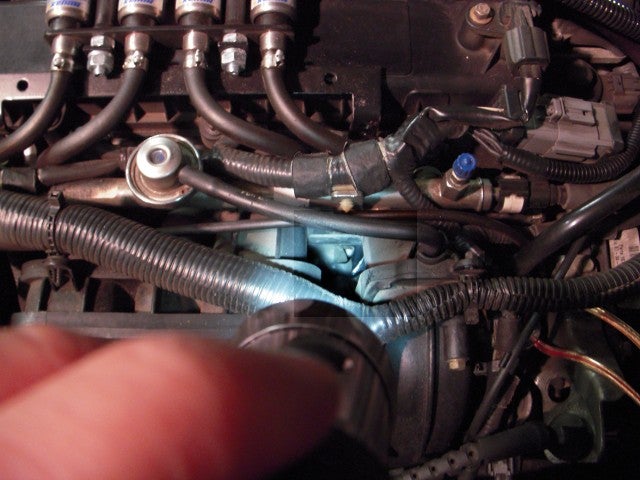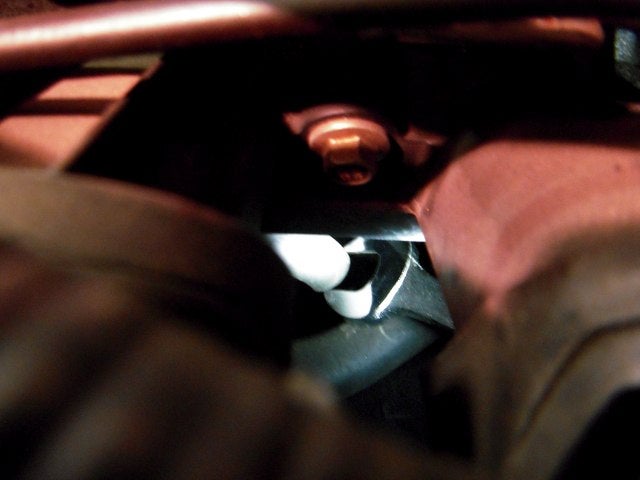Registrations
We now manually approve all new user accounts due to a large influx of spam bots. Accounts are normally approved within 48 hours.
If you need any help with using this Wiki, please ask here: TalkFord.com Wiki Submission Forum
Difference between revisions of "Inlet Manifold Fault - Duratec"
52graphite (Talk | contribs) (→What can I do about it?) |
52graphite (Talk | contribs) (→What can I do about it?) |
||
| Line 50: | Line 50: | ||
* Do nothing. Not recommended, as failure can be sudden. | * Do nothing. Not recommended, as failure can be sudden. | ||
* Remove the flaps and rod completely, and seal up the holes with something like Araldite. Several MEG members have done this and at least one (Dazzaman) has successfully passed an MoT test with the flap movement disabled. A cheap solution that requires a moderate level of skill. | * Remove the flaps and rod completely, and seal up the holes with something like Araldite. Several MEG members have done this and at least one (Dazzaman) has successfully passed an MoT test with the flap movement disabled. A cheap solution that requires a moderate level of skill. | ||
| − | * Replace the | + | * Replace the flaps. A kit was available early on to permit this to be done, and that seems to be available again now. FINIS is F1317276, you'll need four of them. This solution is cheaper and easier than the next one, and retains the intended function of the flaps. See [http://fordmondeo.org/forum/showtopic.php?tid/825176/ this MEG thread] for details. You may also choose to upgrade the oil separator at the same time. |
* Replace the entire manifold. This is the expensive and comprehensive option. Either use a second-hand manifold from a 2003 or later car, or buy a new one direct from Ford. | * Replace the entire manifold. This is the expensive and comprehensive option. Either use a second-hand manifold from a 2003 or later car, or buy a new one direct from Ford. | ||
Revision as of 06:28, 25 January 2010
For the Mk3 Mondeo with a 4-cylinder Duratec petrol engine...
Contents
Background
The 1.8 and 2.0 Duratec-HE petrol engines fitted to Mk3 Mondeos have swirl plates (also called tumble flaps) fitted in the inlet tracts to modify the incoming airflow under certain conditions for allegedly improved smoothness, economy and emissions.
However, the flaps in early vehicles (built up to late 2002) are susceptible to falling apart and getting ingested by the engine. This frequently causes engine damage and has caused several vehicles to be written off. Sometimes this is preceded for a long time by an audible rattle, other times failure is sudden and catastrophic.
Ford are not accepting any liability for this, so don't expect a result there. Feel free to voice your displeasure to them, though.
Affected vehicles
The exact date of introduction of the revised manifold - which appears to have drastically improved the situation - is not exactly known. The closest we can say at the moment is that:
- a 2.0 litre car built on 28 August 2002 had the old manifold;
- a 1.8 litre car built on 16 October 2002 seems to have the revised one, but we can't confirm it hasn't been updated during the car's life;
- a 1.8 litre car built on 4 December 2002 had the revised manifold out of the factory.
Check your build date at eTIS (free registration).
Of course, things can fail on any car. If you have a rattle from the inlet manifold of any age Duratec-HE, it's worth getting it checked out.
How can I tell if I'm affected?
If your car is from around the changeover point, or if you're unsure if the work's already been carried out by a previous owner, the easiest way to establish if your car is affected is to measure the diameter of the oil separator pipe. This seems to have been changed at the same time as the revised manifold was introduced. If the pipe is ½" (just under 13mm) outside diameter, you have the old separator and manifold; if it's ¾" (19mm), you have the new parts. Of course, it's possible an old manifold has been fixed in the past without upgrading the separator.
Unfortunately, this pipe isn't particularly easy to see or access to measure. You need to remove the engine cover first, then your best view of it is with a torch down the gap between the rightmost two cylinders' inlet tracts as you look at the engine. Here's a diagram showing the pipe with the manifold removed:
The photos below show this pipe being checked with a 15mm open-ended spanner inserted in the gap below the throttle body - the old pipe would fit inside 15mm, but as this car has the new pipe, it doesn't fit. You really don't want to drop anything down there - this spanner has a ring on the other end with an old piece of speaker cable threaded through it to act as a safety rope, visible on the right side of the first photo. You could make a gauge out of stout cardboard with "jaws" around 15mm across if you don't have a suitable spanner to hand.
The car in the photos has been converted to LPG, so ignore the bank of injectors at the top of the first photo. Use the fuel rail pulse damper (the shiny cylindrical thing with the black vacuum pipe) just left of centre to locate the area in the engine bay that you need to look.
What happens if it breaks?
Read Robert Jenkins' article for the gory details.
How can I tell if failure is imminent?
Hold the pointy end of a screwdriver on each inlet tract of your running engine in turn, putting the blunt end to your ear. The usual safety notes apply - don't wear a tie or dangle long hair into a running engine. If you can hear a rattle (as opposed to the normal injector ticking sound), you have a problem. However, no rattle doesn't necessarily mean no problem.
What can I do about it?
You have four options, that you can either implement yourself or get a garage to do. Removing the manifold is a fairly lengthy but not particularly tricky job and is covered in a separate article, or alternatively, get the Haynes manual.
- Do nothing. Not recommended, as failure can be sudden.
- Remove the flaps and rod completely, and seal up the holes with something like Araldite. Several MEG members have done this and at least one (Dazzaman) has successfully passed an MoT test with the flap movement disabled. A cheap solution that requires a moderate level of skill.
- Replace the flaps. A kit was available early on to permit this to be done, and that seems to be available again now. FINIS is F1317276, you'll need four of them. This solution is cheaper and easier than the next one, and retains the intended function of the flaps. See this MEG thread for details. You may also choose to upgrade the oil separator at the same time.
- Replace the entire manifold. This is the expensive and comprehensive option. Either use a second-hand manifold from a 2003 or later car, or buy a new one direct from Ford.
More details on all of these can be found in this thread.



 Your Privacy Choices
Your Privacy Choices